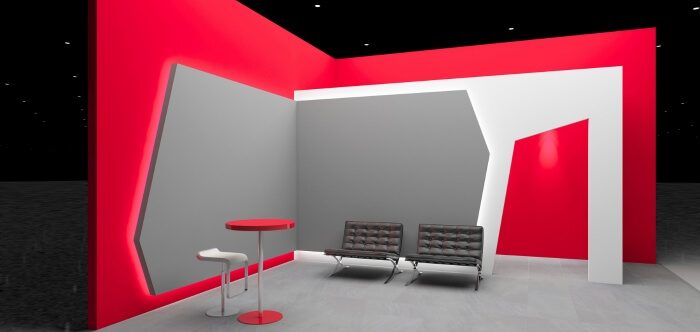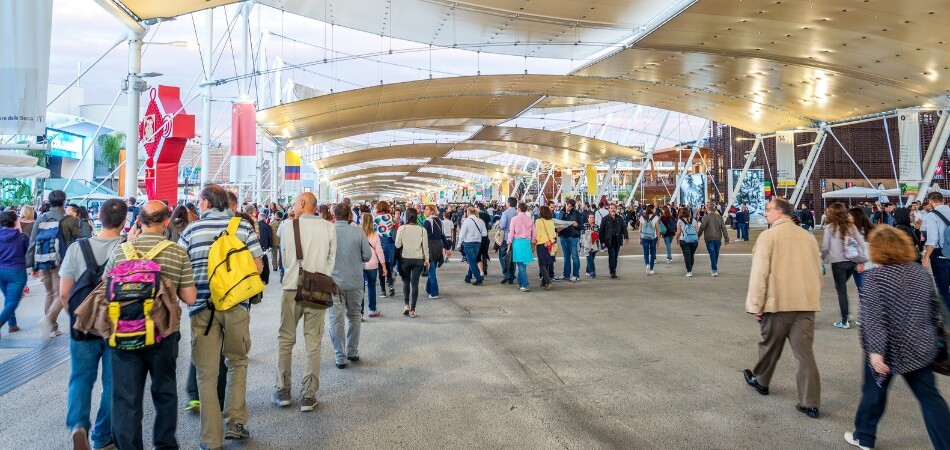Attracting an audience to your exhibition stand amidst a sea of competitors is a challenge every exhibitor faces. What makes a great exhibition stand?
It’s not just about having a big space or the most expensive gadgets. The key lies in capturing attention and invoking curiosity. Eye-catching visuals play a pivotal role. A stand that genuinely stands out is one that’s themed to your brand with consistent colors, fonts, and styles.
Beyond the aesthetics, the subtleties matter, like the strategic use of lighting and the choice of fabrics. But this is just the beginning. Dive deeper as we explore the intricacies that transform an excellent stand into a great one.
What are The Exhibition Stands and What’s Their Purpose?
Exhibitions are vital in marketing, connecting businesses with their target audiences. Central to this are exhibition stands. These intricate structures are more than display areas; they are a brand’s visual voice.

Exhibition stands physically represent a brand or company in trade shows, conferences, and expos. Designed uniquely, these structures convey a brand’s message, products, or services. Through their design and placement, they attract potential clients and partners.
At their core, exhibition stands aim to facilitate face-to-face interactions between companies and prospective customers. These platforms become hotspots for networking, building relationships, and fostering business partnerships. An engaging stand can elevate brand awareness and foster trust among attendees.
Beyond just displaying products, modern exhibition stands have evolved into interactive spaces. Incorporating technology, they offer engaging demos, virtual tours, or interactive touchpoints. This shift transforms them from passive displays into active engagement hubs, enhancing user experience.
What Makes A Great Exhibition Stands?

A great exhibition stand is more than just a display; it’s a compelling representation of a brand’s identity and values in a bustling event space. Here are some key factors that make an exhibition stand truly stand out:
- Design Consistency: An impactful exhibition stand should resonate with the brand’s identity. This includes using consistent colors, fonts, and themes that align with the brand’s message and ethos.
- Engagement: The best stands aren’t just visually appealing; they’re interactive. Whether it’s through technology-driven touchpoints, hands-on product demos, or engaging activities, these stands invite visitors to engage rather than observe.
- Effective Use of Space: A great stand makes optimal use of the available space, ensuring it’s neither too cramped nor wastefully sparse. The layout should facilitate smooth movement and easy interaction for visitors.
- Clear Messaging: Attendees should be able to grasp what the brand offers instantly. This means having clear signage, succinct messages, and compelling visuals that communicate the brand’s value proposition.
- Attention to Detail: Aspects like lighting, sound, and even scent can vastly enhance the experience of an exhibition stand. These subtle elements can set the mood and tone, drawing visitors in.
- Flexibility: The ability to adapt or modify the stand for different events or audience types is valuable. Modular designs that can be reconfigured as needed are a big plus.
- Quality Materials: Durability and aesthetics both matter. Using high-quality materials ensures the stand remains in top condition throughout the event and reflects a professional image.
- Effective Staffing: Well-trained and friendly staff can make a world of difference. They should be knowledgeable about the brand and capable of engaging with attendees in a meaningful way.
- Location: While this is only sometimes within a brand’s control, securing a prime spot in an exhibition can significantly boost foot traffic and visibility.
In essence, an excellent exhibition stand is a harmonious blend of aesthetics, functionality, and brand consistency. When executed well, it can leave a lasting impression, converting curious attendees into potential customers or partners.
How to Create an Eye-Catching Design for Your Exhibition Stand?
In the bustling world of exhibitions, a standout design can make all the difference. Creating a design that captivates and engages is an art in itself. Here’s a step-by-step guide to ensure your exhibition stand grabs attention.
Step-1. Understand Your Brand Identity
Before diving into design, have a clear understanding of your brand’s core values, message, and visual identity. This will serve as the foundation, ensuring your stand is a true representation of your brand.
Step-2. Define Your Objective
Determine what you aim to achieve with the stand. Whether it’s lead generation, product display, or brand awareness, having a clear objective will guide your design decisions.
Step-3. Prioritize Visitor Flow
Consider how visitors will move through your space. An intuitive layout promotes smooth traffic flow, ensuring attendees can engage without feeling overwhelmed or restricted.
Step-4. Incorporate Interactive Elements
Blend technology and hands-on experiences to engage visitors. Whether it’s touch screens, VR demos, or tactile products, interactive features can elevate the visitor experience.
Step-5. Opt for High-Quality Graphics
High-resolution images, clear typography, and consistent brand colors are crucial. They not only convey professionalism but also ensure your stand is visually appealing from both near and far.
Step-6. Strategize Lighting
Lighting can make or break your stand. Utilize ambient, accent, and task lighting to highlight key areas, set the mood, and ensure readability.
Step-7. Include a Focal Point
Every stand should have a standout feature or central element that immediately grabs attention. This could be a product display, an art piece, or a unique design structure.
Step-8. Emphasize Branding
Your brand logo and tagline should be prominently displayed. Position them at eye level and in high-traffic areas to ensure maximum visibility.
Step-9. Choose Quality Materials
Invest in durable, premium materials that reflect your brand’s quality. This ensures longevity and presents a polished, professional image.
Step-10. Gather Feedback
Before finalizing the design, seek opinions from colleagues or target audience members. Fresh perspectives can provide insights and highlight potential areas for improvement.
By following these steps, you’ll be well on your way to designing an exhibition stand that not only captures attention but also leaves a lasting impression on attendees.
Types of Exhibition Stands at an Expo
Expos serve as vibrant platforms for brands to showcase their offerings. Central to these events are the exhibition stands. Diverse in design and purpose, these stands fall into distinct categories.
Modular Stands
Modular stands are flexible and can be adjusted for different expo spaces. These reconfigurable designs can adapt to various events. High-quality graphics and components make them reusable.
Pop-Up Stands
Compact and portable pop-up stands offer quick setups for exhibitors. They’re ideal for smaller events or supplementary displays within larger booths. With foldable frameworks, they’re easy to transport and store.
Bespoke Stands
Bespoke stands are custom-designed for a specific brand or event. Offering a unique presence, they reflect the brand’s personality perfectly. However, they often require larger budgets and longer setup times.
Shell Scheme Stands
Often provided by event organizers, shell scheme stands are pre-defined spaces within an expo. Exhibitors can customize these with their graphics and displays. They’re cost-effective and straightforward for first-time participants.
Double-Decker Stands
Double-decker stands have two levels, which maximize vertical space. The ground level facilitates product displays and interactions. The upper deck, often reserved for VIPs, offers a panoramic event view.
Understanding the types of exhibition stands helps brands select the ideal setup for their expo participation, ensuring their message is communicated effectively to the target audience.
Does Exhibition Vendor Help Make it Stand Out?
Absolutely, an exhibition vendor plays a pivotal role in ensuring a stand not only meets the functional needs of the exhibitor but also stands out in a crowded expo environment. Here’s how:
- Expertise and Experience: Exhibition vendors come with knowledge of the latest trends, materials, and technologies in the exhibition world. Their expertise ensures the stand is modern, relevant, and resonates with the target audience.
- Customization: A skilled vendor can customize the stand to reflect the brand’s unique identity, values, and objectives. This bespoke approach ensures the stand is distinct and memorable.
- Quality Materials and Construction: With their industry connections, vendors have access to quality materials and skilled craftsmen. A well-constructed stand not only looks professional but also withstands the wear and tear of busy expo days.
- Integration of Technology: Today’s exhibition stands often incorporate technology for interactive displays, lighting effects, or digital presentations. Vendors can seamlessly integrate these elements, enhancing visitor engagement.
- Logistical Support: Beyond design and construction, vendors assist with transportation, setup, and teardown of the stand. This comprehensive support ensures the stand is presented in its best form without any hitches.
- Feedback and Iteration: An experienced vendor can provide feedback on the stand’s design based on past projects and industry best practices. This collaborative approach can lead to a more effective final design.
- Cost-Effectiveness: While there’s an investment in hiring a vendor, their industry relationships and bulk purchasing power can often lead to cost savings in materials and construction.
While it’s possible for a brand to attempt a DIY approach to their exhibition stand, partnering with a seasoned exhibition vendor significantly boosts the chances of creating a standout, effective, and hassle-free display.
How Should an Exhibition Vendor Dress?
The attire of an exhibition vendor can significantly influence their first impression. It’s a blend of professionalism, brand representation, and comfort. Let’s explore the ideal dress code for exhibition vendors.

Brand Consistency
Vendors should wear attire that aligns with the brand they’re representing. This ensures a cohesive image and strengthens brand identity. Logos or brand colors can be subtly incorporated.
Professional Appearance
Regardless of the brand style, vendors should always appear professional. Clean, well-fitted clothing boosts credibility and trust among attendees. Avoid overly casual wear like flip-flops or shorts.
Comfort is Key
Expos can be long and exhausting for vendors. Opting for comfortable shoes is essential to endure hours of standing. Breathable fabrics can enhance comfort during extended shifts.
Accessible Identification
Wearing a clear name tag or badge aids in identification. It allows attendees to address vendors personally, facilitating better interactions. This also offers a sense of transparency and approachability.
Adapt to the Environment
Consider the setting and nature of the expo. For outdoor events, hats or sunglasses might be appropriate. Indoor, upscale events might demand more formal attire.
In essence, the attire of an exhibition vendor should reflect the brand, ensure comfort, and maintain professionalism, all while adapting to the event’s unique environment.
End Notes
Creating a memorable presence at an exhibition is a culmination of various elements. At its core, what makes a great exhibition stand is not just its visual appeal but its ability to resonate with a brand’s ethos and attract the target audience.
It’s about weaving the brand’s identity seamlessly into the design, ensuring interactivity, and presenting a professional image. From the strategic placement of lighting to the attire of the vendors, every detail plays a part in capturing attention.
The choice of stand type, the expertise of the exhibition vendor, and the incorporation of innovative features all converge to create a stand that truly stands out. Exhibitions are dynamic, and the stands should be too, evolving and adapting to ensure they always make a lasting impression.


